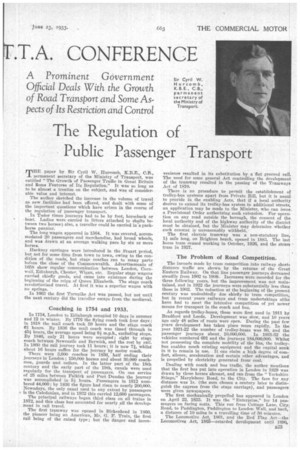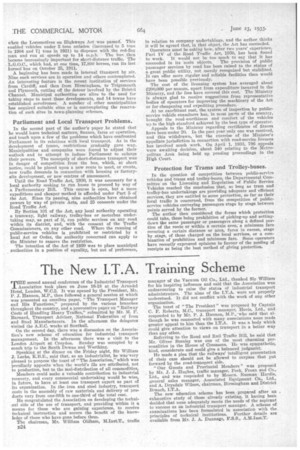The Regulation of Public Passenger Transport
Page 37

Page 38

If you've noticed an error in this article please click here to report it so we can fix it.
T"paper by Sir Cyril W. Hurcomb, K.B.E., C.B., permanent secretary of the Ministry of Transport, was entitled " The Growth of Passenger Traffic in Great Britain son{ Some Features of Its Regulation." It was so long as to be almost a treatise on the subject, and was of considerable Yalue and interest.
The author sketched the increase in the volume of travel as new .facilities had been offered, and dealt with some of the important questions which have arisen in the course of the regulation of passenger transport.
. In Tudor times journeys had to be by foot, horseback or boat. Ladies were carried in litters attached to shafts between two horses; also, a traveller could be carried in `a packhorse pannier.
The long wagcin appeared in 1564. It was covered, accommodated 20 passengers and merchandise, had broad wheels, and was drawn at an average walking pace by six or more horses.
Hackney carriages were introduced in the fRuart period, but not for some time from town to town, owing to the condition of the roads, but stage coaches ran to many parts before the close of the Commonwealth. Advertisements of 1658 show regular eommunication between London, Cornwall, Edinburgh, Chester, Wigan, etc. Regular stage wagons carried chiefly goods, and came into existence during the beginning of the reign of Queen Elizabeth. The stage coach revolutionized travel. At first it was a superior wagon with o springs. •
In 1663 the first Turnpike Act was passed, but not until the next century did the traveller escape from the medheyal.
Coaching in 1754 and 1933.
In 1754, London to Edinburgh occupied 10 days in summer and 12 in winter. By 1776 the flying coach took four days ; in 1818 the mail coach took 59 hours and the siege coach III hours. By 1836 the mail coach was timed through in 45i hours, the average speed being 9i m.p.h., excluding stops. By 1846, only 21 hours were occupied ; eight by stage coach between Newcastle and Berwick, and the rest by rail. In 1860 the rail journey took 11 hours; it is now 7i, whilst about 16 hours suffice for the journey by motor coach. There were 3,000 coaches in 1836, half ending their journeys in London ; 150,000 horses and about 30,000 coachmen, guards and ostlers. In the latter part of the 18th century and the early part of the 19th, canals were used regularly for the transport of passengers. On one service of 25 miles between Falkirk and Port Dundas the journey was accomplished in 51. hours. Passengers in 1812 numbered 44,000; by 1.836 the figure had risen to nearly 200,000. Nowadays, the only canal used to any extent by passengers is the Caledonian, and in 1932 this carried 12,600 passengers.
The principal railways began third class on all trains in 1872, and this class has accounted for nearly all the development in rail travel.
The first tramway was opened in Birkenhead in 1860, the pioneer being an American, Mr. G. F. Train, the first rail being of the raised type ; but the danger and incon
venience resulted in its substitution by. a flat grooved • rail. The need for some general Act controlling the development of the tramway resulted in the passing of the Tramways Act of 1870.
There is no procedure to permit the establishment of trolley-bus systems apart from Private Bill, but it is usual. to provide in the enabling Acts, that if a local authority desires to extend its trolley-bus system to additional Streets, an application may be made to the Minister, who can issue. a Provisional Order authorizing such extension. For operation on any road outside the borough, the consent of the local authority and of the highway authority of the district must be obtained, but the Minister may determine whether such consent is unreasonably withheld.
The first electric tramway was a non-statutory line, 13mile long, on Brighton beach, opened in 1883. The last horse tram ceased working in October, 1926, and the steam • tram in 1927.
The Problem of Road Competition.
The inroads made by tram competition into railway shortdistance traffic are shown by the returns of the Great Eastern Railway. On that line passenger journeys decreased steadily from 1902 to 1909. Increases were recorded for the three following years, but the improvement was not maintained, and in 1922 the journeys were substantially less than those in 1902, The reduction at the beginning of the present century was undoubtedly due chiefly to tram competition, but in recent 'years railways and tram undertakings aliki3 have bad to meet the intensive competition of yet newer means for transport in the coach and bus.
As regards trolley-buses, these were first used in 1011 by Bradford and Leeds. Development was slow, and 10 years ago only 48 miles of route were open. During the past few years development has taken place more rapidly. In the year 1921-22 the number of trolley-buses was 80, and the passenger journeys about, 10,000,000. In 1931-32 the vehicles numbered 691 and the journeys 184,000,000. Whilst not possessing the complete mobility of the tins, the trolleybus enables much existing equipment and the capital sunk in it to remain in use. It can claim a high degree of comfort, silence, acceleration and certain other advantages, and is propelled by electricity generated from coal.
Dealing with coach and bus traffic, the author mentions that the first bus put into operation in London in 1829 was drawn by three horses abreast, and ran from the " Yorkshire Stingo," Marylebone Road, to the City. The fare for any distance was 1s. (the sum chosen a century later to distinguish the express from the stage carriage), and passengers were given newspapers.
The first mechanically propelled bus appeared in London on April 22, 1833. It was the "Enterprise," for 14 passengers on facing seats. This ran from Cottage Lane, City Road, to Paddington, Paddington to London Wall, and back, a distance of 10 miles in a travelling time of 50 minutes.
The Locomotive Act, 1861, and the Red Flag Act—the Locomotives Act, 1865—retarded development until 1896, when the Locomotives on Highways Act. was passed. This enabled vehicles under 3 tons unladen (increased to 5 tons in 1904 and 71 tons in 1921) to dispense with the red-flag man and run sat speeds up to 14 m.p.h. The bus .then became increasingly important for short-distance traffic. The L.G.O.C., which bad, at one time, 17,800 horses, ran its last horsed bus on October 25, 1911.
A. beginning has been made in internal transport by air. Nine such services are in operation and others contemplated. An interesting feature is the recent institution of services from Cardiff, and then from Birmingham, to Te.ignmouth and Plymouth, cutting off the detour involved by the Bristol Channel. Municipal authorities are alive to the need for taking steps to meet these developments, and 14 towns have established aerodromes. A number of other municipalities has acquired suitable sites or is contemplating the reservation of such sites in town-planning schemes.
Parliament and Local Transport Problems.
In the second part of the author's paper he stated that he would leave technical matters, finance, fares or operation, and touch upon a few of the problems which have confronted Parliament in its relations with local transport. As in the development of trains, restrictions gradually gave way. Municipalities and companies were forced to adjust their outlook and to attempt to induce Parliament to enlarge their powers. The monopoly of short-distance transport was in danger of competition from the bus, which, at short notice, could be placed upon a new route to meet, or create, new traffic demands in connection with housing or factorysite development, or new centres of amusement.
Until the Road Traffic Act, 1930, it was necessary for a local authority seeking to run buses to proceed by way of a Parliamentary Bill. This course is open, but a more expeditious and cheaper method is afforded under Part 5 of the Act. Since its passing, nine authorities have obtained powers by way of private Acts, and 25 consents under the Road Traffic Act.
• By Section 101 of the Act, any local authority operating a tramway, light railway, trolley-bus or motorbus undertaking may, as part of it, run public services on any road within its district, and, with the consent of the Traffic Commissioners, on any other road. Where the running of public-service vehicles is prohibited or restricted by a local Act or Order, the authority concerned can apply to the Minister to remove the restriction.
The intention of the Act of 1930 was to place municipal authorities in a position of equality, but not of preference, in relation to company undertakings, and the author thinks it will be agreed that, in that object, the Act has succeeded. Operators must be asking how, after two years' experience, Part IV of the Road Traffic Act, •1930, has been found to work. It would not be too much to say that it has succeeded in its Main objects. The provision of public passenger services by road has been raised to the status of a great public utility, not merely recognized but stabilized. It can offer more regular and reliable facilities than would have been possible previously.
The cost of the licensing system has averaged about £200,000 per annum, apart from expenditure incurred in the Ministry, and the fees have covered this cost. The Ministry is always glad to receive suggestions from representative bodies of operators for improving the machinery of the Act or for cheapening and expediting procedure. At no exorbitant cost, the system of inspection by publicservice vehicle examiners has, in most parts of the country, brought the road-worthiness and comfort of the vehicles un to the high standard achieved by the best type of operator.
Appeals to the Minister regarding certificates of fitness have been under 20. In the past year only one was received, and this withdrawn, but the exercise of the Minister's appellate jurisdiction in connection with road-service licences has involved much work. On April 1, 1933, 786 appeals were awaiting decision about 540 relating to the Metropolitan Area being held up pending proceedings in the High Court.
Protection for Trains and Trolley-buses.
In the question of competition between public-service vehicles and trams and trolley-buses, the Departmental Committee on the Licensing and Regulation of Public Service Vehicles reached the conclusion that, so long as tram and trolley-bus undertakings are providing adequate and efficient services, they are entitled to some protection, so far as their local traffic is concerned, from the competition of publicservice vehicles conveying passengers stage by stage between points served by the former. The author then considered the forms which protection could take, these being prohibition of picking-up and settingdown the same passenger or passengers along a defined portion of the route or within a certain area, a minimum fare covering a certain distance or area, fares in excess, stage by .stage, af those charged on the local services, or a combination of prohibition and minimum fare. Some operators have recently expressed opinions in favour of the pooling of receipts as being the best method of giving protection.




























































































